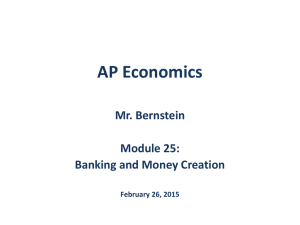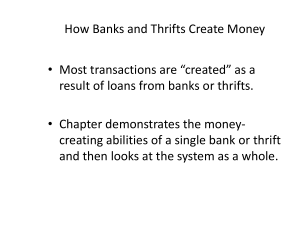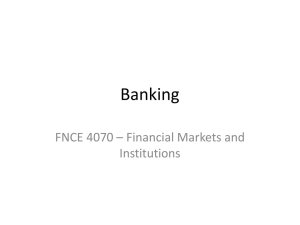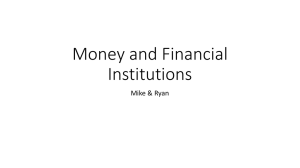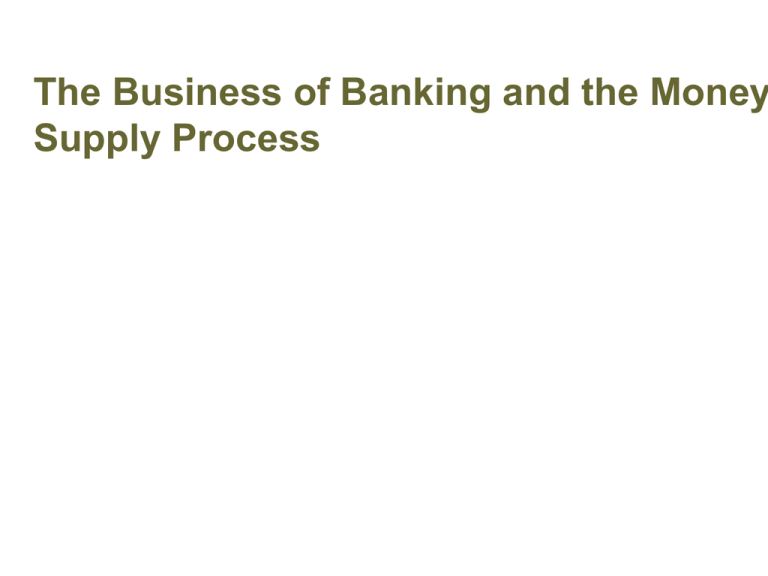
The Business of Banking and the Money
Supply Process
Banking and Money Supply
What Are Banks?
• Investment banks.
• Central Banks
• Commercial Banks
• Savings Banks
• Credit Unions
Bank Liabilities and Net Worth
• Checkable deposits
• Nontransaction deposits
• Borrowings
• Net worth
Bank Assets
• Cash Items
• Securities
• Loans
• Other Assets
Example
Bank of 331
Assets
Liabilities
Loans
$300
Demand Deposits
$200
Reserves
$20
Non Transactions Dep $100
Securities
$10
Borrowings
$75
Other Assets $100
Net worth (Equity)
$65
$430
$430
Balance Sheet of U.S. Commercial
Banks, 2003
3 sorts of risk
• Liquidity Risk- The risk that at any given
time, banks will not able to pay its
depositors and meet its reserve
requirements. Bank Failure
• Credit Risk- The risk that borrowers
may default
• Interest rate risk- if market interest rate
changes cause profits to fluctuate.
Managing Capital Adequacy
• Important variables which stakeholders
look at: ROA- net after tax profit/Bank
assets, ROE- net after tax profit/Bank
equity
Risk of Bank Runs
• Banks’ loans cannot be liquidated quickly,
even if they are short term
• Short-term depositors lack information about
the quality of banks’ loans. Same public
goods problem prevents private providers
from publicizing banks’ problems
• If depositors hear others are withdrawing,
they know it may cause a bankruptcy
• Banks are in unstable equilibrium
Money Supply
• What is the major way in which the fed
attempts to guide the banking system
and the economy?
• Adjusting the money supply—increasing
and decreasing the liquidity in the
system.
Copyright © 2005 Pearson Addison-Wesley. All rights reserved.
17-13
Why is money supply important?
• Affects price levels
• Affects interest rates
• Affects growth rate
• Affects exchange rates
• *Refresher- MS has many definitionsfor now, we stick with
M1=currency+deposits
The Money Supply Process
(Model to explain the size and variability
of money supply)
Three groups affect the money supply
process:
– Central bank: responsible for monetary
policy
– Depository institutions (banks): accept
deposits and make loans
– Non-bank public: holds money as currency
and deposits, and demands loans
What is the Monetary Base?
• Technically- it is the liabilities of the Fed
• Monetary Base= currency in circulation+
reserves (B=C+R)
• Federal currency in circulation is a liability (to
the non-bank public)
• Cash kept in banks is called vault cash and is
counted as part of reserves.
• Bank reserves are assets held by banks that
they can collect from the fed but…
Reserves
• .. Bank reserves pay no interest- so to banks,
holding reserves gives them no money.
• By law, commercial banks are made to hold a
certain amount of bank reserves (called
‘required reserves)
• So.. total reserves= required reserves+
excess reserves.
• The percentage of deposits of a bank that are
require to be held as reserves is called the
required reserve ratio (what purpose?)
Fed’s assets
• Gold
• Government Securities (U.S treasury
obligations)
• Discount loans (loans it makes to banks
at a particular interest rate- the interest
rate is called the discount rate)
B. Banks’ balance sheet
Commercial Bank
Assets
+ Reserves
+ Loans
(+other)
Liabilities
+ Deposits = DEP
(+ other)
Central Bank
Assets
+ Govt. securities
+ Discount loans to banks
+ Gold
Liabilities
+ Currency in circulation: C
+ Banks’ vault cash Total reserves
=R
+ Banks’ deposits
(BASE = C + R)
Changing the Monetary Base
• The Fed changes the monetary base by
changing the levels of its assets.
• Two major ways:
1- Open market operations
2- Discount loans
Open market operations
• In an open market purchase the Fed buys
government bonds and increases the base.
Say the fed wanted to increase money supply by $1
million. It makes a check payable from the Fed to the
seller of the bond (either the non-bank public or a
bank). This draws out the securities that were there in
the system and replaces it with either currency (if the
bank or public wants to hold it as currency) or with
reserves (if the bank puts it into reserves). In either
case since B=C+R , the base increases (either C
goes up by $1 million or R does or some proportion
of both)
The Effect of Open Market
Operations
Fill in the blanks
• In order to decrease the money base
the Fed ____ government securities. As
a result the non-bank public and/or the
banks_____ the government securities
with their deposit accounts and or
reserves. As a result, C + R _______
which results in B _______
The discount loan
• The Fed can also change reserves and the
base through changes in discount loans.
• Fed sets discount rate (rate at which banks
borrow from the fed). When this is low, banks
will borrow more, thereby increasing
reserves.
• Discount loans are a less effective method
than the OMO method, because banks have
to choose to borrow for reserves to go up.
The Effect of Discount Loans
Determinants of the BASE: BASE=C+R
Fed
Banks
-OMO
-Reserves
-Discount
lending
-Currency in
circulation
-Vault cash
Reserves
-Deposits at
Fed
Non-bank
public
-Deposits
checks
-Holds
currency
-Reserves
-Currency in
circulation
BASE
The Simple Deposit Multiplier
• The money multiplier links monetary
base changes to changes in the money
supply.
Example
• Let us take bank A. This is the bank from which the Fed has
bought $10 of securities. Let us assume that the fed has set a
10% rrr (required reserve ratio). The fact means that since this
money has not come from a deposit, it can lend this out to a
business. So it creates a checking account for the firm and puts
this money in it so that..
• Bank A has the following balance sheet
Assets
Liabilities
Securities = -$10
Reserves = $10
Loans
= $10
Deposits = $10
But things don’t stop there…
• Let us assume that the firm which has taken a loan spends all of
its money on tools and equipment . Let us assume that this
money is now deposited in bank B . There is still a 10% rrr
(required reserve ratio). Now since this money has from a
deposit, the bank B has to keep 10% as reserves so that it
keeps $1. It now has excess reserves of $9 which it wants to
lend out. Now..
• Bank B has the following balance sheet
Assets
Liabilities
Reserves = $1
Deposits = $10
Loans =
$9
But things don’t stop there either
• Let us assume that the firm which has taken a loan from bank B
now spends all of its money on tools and equipment . Let us
assume that this money is now deposited in bank C . There is
still a 10% rrr (required reserve ratio). Now since this money has
from a deposit, the bank B has to keep 10% as reserves so that
it keeps 90 cents (10% of $ 9). It now has excess reserves of
$8.10 which it wants to lend out. Now..
• Bank B has the following balance sheet
Assets
Liabilities
Reserves = $0.9
Deposits = $9
Loans =
$8.1
The simple deposit multiplier and the
process of multiple deposit creation
• What is happening here. Deposits have increased as
follows: $10 in bank A+$9 in bank B+$8.1 in bank
C+..
• Multiple deposits are created
• Formula: DD=DR+DR[1-.1]+DR [1-.1]2+.. Formula:
DD=DR+DR[1-rrr]+DR[1-rrr]2+..
• Simple deposit multiplier: DD = DR {1/(rrr)}; where D
= deposits , R = reserves, and R/D = required
reserve ratio.
• So in our example, deposits would increase as
follows
• DD = DR {1/(rrr)}
• DD= 10{1/.1}=10/.1=$100
Decisions of the Nonbank Public
change this…
• The simple deposit multiplier model
incorrectly assumes no currency and no
excess reserves.
• Behavior of the nonbank public and banks
influences the money supply.
• The ratio of cash to checkable deposits is
called the currency-deposit ratio, (C/D).
• Changes in C/D by nonbank public will
change the money supply.
Table 17.2 Determinants of the
Currency-Deposit Ratio
Bank Behavior: Excess Reserves
and Discount Loans
• Banks sometimes hold excess reserves,
reducing the size of the money multiplier.
• Banks’ decisions to incur discount loans affect
the size of the monetary base.
• Banks generally hold small levels of excess
reserves, but the amount fluctuates over time.
• The level of discount loans is determined by
banks.
• Decisions by banks affect Excess
Reserves/Deposits ratio
– Principal determinant = opportunity cost of holding
reserves.
– Empirical fact: er = inversely related to the interest
rate
Figure 17.4 Excess Reserves and
Discount Loans (1959-2003)
Table 17.3 Determinants of Excess
Reserves and Discount Loans
Deriving the Money Multiplier and
the Money Supply
• The money supply equals the money
multiplier times the monetary base.
• The monetary base = nonborrowed
base + discount loans.
• The money multiplier depends on the
required reserve ratio, ER/D, and C/D.
C. The money multiplier
The money multiplier m is such that:
Money Supply = m * Monetary Base
M = m * BASE
m = M/BASE
m = (C + D) / (C + R)
m = (C + D) / (C + RR + ER)
m = (C/D + 1) / (C/D + RR/D + ER/D)
m = (cu +1) / (cu + rrr + er)
M= [(cu +1) / (cu + rrr + er)] Base
Money multiplier: a special case
From: m = (cu +1) / (cu + rr + er),
If the public holds no currency and banks hold no
reserves, that is, cu = 0 and er = 0 then we get the
simple deposit multiplier (m’):
m’ = 1/rr = 1/(RR/D)
Example
• Let ER=0, rrr=10%, C/D=30%, what
happens to the money supply if central
bank buys $10 million of govt
securities?
DM= [(cu +1) / (cu + rrr + er)] DBase
=[(1+0.3)/(0.1+0.3)] $10 million
=(1.3/0.4)* $10 million=$32.5 million
Decomposing the money multiplier
m=(cu+1)/(cu+res+eres)
Fed
Sets rr
rr
Banks
-Issue loans
er
- Borrow from
Fed or in FFM
Non-bank
public
-Holds
currency
-makes
deposits
-demands
loans
cu
er
m
E. Money multiplier and the business cycle
• The money multiplier usually falls during recessions
Causes: high liquidity preference by the public
(high cu) and by banks (high er)
• Changes in the money multiplier dampen or amplify
changes in the BASE.
– Ex: 1930-1933, M fell by 28% even though BASE grew by
20%
Variables in the Money Supply
Process
Accounting for
Changes in
the Money
Supply (M1),
1979-2003


